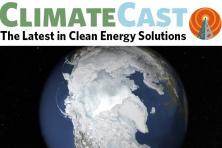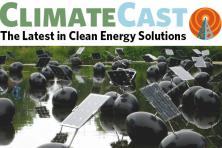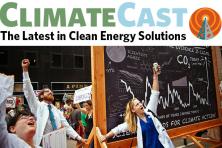West coast, best coast for climate action
Climate Solutions demonstrates how the Northwest can go fossil free with the release of a white paper showing not only that it is possible to achieve a 100% clean electricity grid, but that it’s not that complicated or expensive. Washington and Oregon are both getting closer to passing proposals to reduce climate-harming carbon emissions -- Washington State with Initiative 1631 on the fall ballot, and Oregon with a cap-and-invest bill in the 2019 state legislature. In other Northwest climate action, the Oregon Public Utility Commission has developed a road map to help the electric sector tackle climate change and equity; Seattle University will become the first university in Washington, and the first Catholic university in the U.S., to divest from fossil fuels. In California, Governor Jerry Brown declared that the state will “launch its own damn satellite” to track point source climate pollution amid continued concerns about federal federal budget cuts undercutting NASA’s climate research role.
Opposing clean energy is no longer an option
All across the US, the public is making it increasingly clear that a clean energy future is what they want. A majority of US utility customers want their providers to utilize 100 percent clean energy. 51 percent of those polled also believe that 100 percent renewables is a good idea, even if it raises their energy bills by 30 percent. Their message from the public is clear: they want clean energy, and they’re willing to pay for it. The East Coast is flexing its climate action muscles, with New York, Maryland, and Connecticut have announcing plans to phase-out of hydrofluorocarbons -- climate “super pollutants” used in air conditioners and refrigeration systems. Back on the West Coast, California hosted the Global Climate Action Summit to help spur stronger climate action commitments in advance of this fall’s climate negotiations in Poland.
Clean energy: nimble, resilient and seemingly everywhere
Washington State’s last coal plant may soon become the site of its largest solar project, as the company that runs the plant is looking to open a solar farm on one of the plant’s former open-pit mines. As the president of the West Virginia Coal Association recently acknowledged, coal is losing ground. Falling battery costs are making it increasingly possible for solar to deliver electricity after dark, making solar projects cheaper to build in parts of the U.S. Southwest than gas.
Recent headlines show that when the going gets tough, clean energy keeps going. All solar taken offline during Hurricane Florence was quickly back online and providing power -- including residential solar, where installers reported only minimal damage. In Europe, which experienced extreme heat waves this summer, solar generation broke records -- showing how renewable energy makes us more resilient in a warming world. Solar is so widely demanded that, despite the turmoil and uncertainty of proposed tariffs on imported solar modules and cells, the industry continues to grow. New reports show that utility solar project procurement soared, while community solar continues to see rapid growth.
Next: transportation without fossil fuels.
While biofuels have been available as an aviation fuel for some time, they are finally taking off. Several major airlines will utilize biofuels to cut their carbon emissions in half by 2005 levels in order to match an industry target set by the International Air Transport Association. Back on the ground, TriMet has proposed a new plan to phase out diesel buses and purchase emission-free electric buses over the next 22 years. A global electric charging station provider plans to install 1 million EV chargers by 2025 -- a 1,500-percent increase in installations in just seven years.
The terrifying hurricanes and typhoons of a warming world
While Hurricane Florence dominated US news headlines, the planet’s strongest storm in 2018 hit the northern Philippines and Hong Kong. Super Typhoon Mangkhut has caused landslides that buried entire villages, has killed over 100 people, and over 100 more are still missing. Hurricane Florence also caused extensive damage, including the deaths of at least 31 people, while many more people have been stranded and thousands left without power. The North Carolina Department of Environmental Quality reports that over 50 hog-waste pits have been inundated with floodwaters, leading them to spill toxic, bacteria-laden contents into flooded fields and beyond. Floodwaters also engulfed toxic ash ponds at a local coal plant, potentially contaminating the nearby Neuse River with heavy metals.
The intensity and duration hurricanes and typhoons are increasing because of climate change. Florence has been called a thousand-year rain event, and researchers estimate that Hurricane Florence’s rainfall forecast was 50 percent higher because of warmer oceans and more moisture in the atmosphere brought on by climate change. While these storms impact everyone in their wake, they do so disproportionately. Storms like Florence and Mangkhut hit poor, minority communities the hardest because these communities have the least means to evacuate, prepare for or recover from such disasters. These storms provide a stark reminder that those least responsible for climate change are suffering most from its impacts.
In brief: Even our oceans are gasping for air
Ocean hypoxia occurs when oxygen in the water is so low, very few organisms can survive. It used to be a harmful but infrequent event along the Oregon coast. Then in 2002, dead crabs were hauled up in crab posts. Scientists thought it to be a one-time anomaly brought on by an odd combination of climate, winds and upwelling patterns. But each year after that, things got a bit worse. Now, scientists say warming ocean temperatures mean that Oregon’s coastal waters are subject to a hypoxia season -- much like how the West has a wildfire season. Global warming is changing the world as we know it, with implications we don’t yet fully understand.





